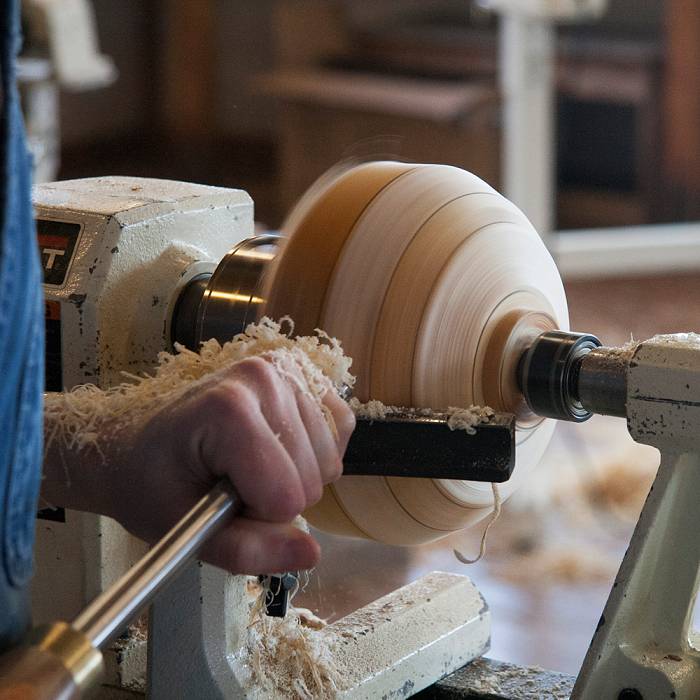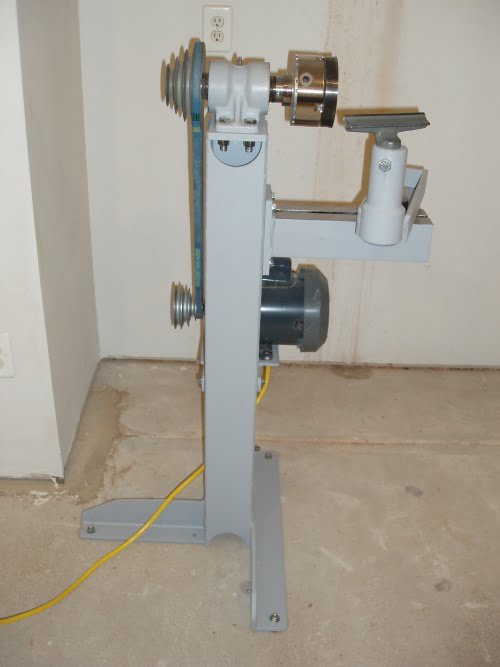Table of Contents
A wood lathe for bowl turning is essential for creating smooth, symmetrical bowls. It allows precise shaping and finishing of wooden bowls.
Wood lathes are crucial tools for woodworkers, especially those specializing in bowl turning. These machines spin a wood piece at high speeds, enabling artisans to shape and hollow it efficiently. A wood lathe’s versatility extends to crafting various sizes and styles of bowls.
With the right accessories and tools, woodworkers can achieve smooth finishes and intricate designs. Selecting the appropriate lathe depends on factors like motor power, speed options, and bed length. Investing in a high-quality wood lathe ensures durability and precision, making it a valuable addition to any woodworking workshop.
Introduction To Bowl Turning On A Wood Lathe
Crafting wooden bowls is fun. It lets you make beautiful items. Bowls can be useful and decorative. The wood lathe helps turn wood into shapes. You can make smooth, round bowls. The wood feels nice to touch.
Working with wood is relaxing. It’s a hobby that brings joy. Creating something from wood feels magical. You take a simple log. Then, you turn it into a work of art. People admire handmade bowls. They make great gifts too.
- Wood lathe: The main tool for shaping wood.
- Chisels: Used for carving and detailing.
- Face shield: Protects your eyes and face.
- Sandpaper: Makes the bowl smooth.
- Calipers: Measures the thickness of the bowl.
Selecting The Perfect Wood
Hardwoods like maple, oak, and walnut are great for bowl turning. These woods are strong and durable. Softwoods such as pine and cedar are also used. They are easier to work with but less durable. Exotic woods like ebony and rosewood add a unique look. They can be more expensive and harder to find. Fruitwoods like apple and cherry offer a pleasant aroma. They are medium-hard and easy to turn.
- Grain pattern – Affects the beauty and finish.
- Wood hardness – Determines ease of turning.
- Availability – Some woods are hard to find.
- Cost – Exotic woods are pricier.
- Aroma – Some woods smell nice when turned.
Preparing The Wood For Turning
Preparing wood for turning on a lathe involves careful selection and preparation of the blank. Ensure the wood is properly dried and free from cracks for a smooth and safe bowl turning experience.
Cutting And Shaping The Blank
Start by selecting a wood piece. Cut the wood into a rough round shape. Use a bandsaw or chainsaw for this. Make sure the wood is securely mounted on the lathe. Safety should be your top priority. Wear safety goggles and gloves.
Mark the center of the wood blank. This helps in aligning it on the lathe. Use a compass to draw a circle. Remove excess wood outside the circle. This makes the wood easier to turn. Always double-check the security of the wood.
Moisture Content And Its Impact
Moisture content in wood is crucial for turning. Wood with high moisture is easier to turn. However, it may warp as it dries. Dry wood is harder to turn but more stable. Use a moisture meter to check levels. Aim for wood with 10-20% moisture.
Drying the wood before turning is important. Store wood in a dry place. This helps to reduce moisture content. Avoid rapid drying to prevent cracking. Slow drying is best for stability. Always check moisture before starting.
Setting Up The Wood Lathe
The headstock holds the spindle and motor. It is the power source. The tailstock supports the other end of the workpiece. The tool rest guides your tools. The bed is the base that holds everything together. The spindle spins the wood. The motor powers the spindle. Each part has a special job. Together, they make bowl turning possible.
First, set the tool rest close to the wood. It should be just below center. Next, adjust the tailstock to support the wood. Make sure it is tight. Then, check the speed of the lathe. Start slow. Increase speed as needed. Always wear safety gear. This includes goggles and a mask. Safety is very important.
Mastering Lathe Tools And Techniques
Proper tools are key in bowl turning. Chisels and gouges are essential. Choose a bowl gouge for rough shaping. Use a scraper for fine details. A parting tool helps to separate the bowl from the wood block. Always make sure tools are sharp. Sharp tools make cleaner cuts. Quality tools last longer and perform better.
Start with a slow speed on the lathe. This gives better control. Hold the tool firmly but gently. Move smoothly along the wood. Make shallow cuts for a better finish. Avoid forcing the tool. Let the tool do the work. Check your progress often. A smooth finish comes from patience and practice.
Credit: carterandsontoolworks.com
Safety Measures For Bowl Turning
Ensure safety by wearing protective gear, securing the wood lathe, and maintaining sharp tools. Always check for proper alignment before starting bowl turning.
Personal Protective Equipment
Always wear safety glasses to protect your eyes. Ear protection helps save your hearing from loud noises. Dust masks keep harmful particles out of your lungs. Gloves can offer some hand protection but use them carefully. Face shields provide extra safety for your face.
Lathe Operation Safety Tips
Check the lathe before starting. Ensure all parts are tight and secure. Keep tools sharp for smooth cutting. Never leave the lathe running unattended. Maintain a clean workspace to avoid accidents. Use the correct speed for the size of the bowl.
Finishing Touches For Your Bowl
Use fine-grit sandpaper to smooth your bowl. Start with 80-grit sandpaper. Sand the bowl evenly. Move to 120-grit sandpaper next. Sand in a circular motion. Use 220-grit sandpaper for final sanding. Wipe the bowl with a damp cloth. This removes dust.
Choose a food-safe finish for your bowl. Mineral oil is a good choice. Apply a thin coat of oil. Let it soak in for 15 minutes. Wipe off extra oil with a cloth. Let the bowl dry for a few hours. Repeat if needed for a shiny finish.

Credit: turnawoodbowl.com
Advanced Bowl Turning Techniques
Bowl turning can be more fun with embellishments. Use burning tools to create designs. Painting adds color to your bowls. Carving can make your bowl look unique. Inlays add special touches with different materials. Textures give a nice feel to your bowl. Try to mix different techniques. Each bowl can be a new adventure.
Complex designs can be tricky. Plan your design carefully. Sharp tools make the job easier. Patience is key. Practice helps improve your skills. Safety gear is important. Templates can guide your work. Take breaks to avoid mistakes. Don’t rush your design. Learn from each project. Each challenge makes you better.
Showcasing Your Craft
Show your bowls in a well-lit area. Use shelves to display them. Bright lighting makes the wood look better. Arrange bowls by size and color. People will notice the unique designs. Place tags with the price and wood type. This helps buyers know more. Clean bowls often to keep them shiny.
Use social media to show your bowls. Post pictures on Instagram and Facebook. Write a short story about each bowl. This makes them more special. Join local craft fairs. You can meet buyers face to face. Create a simple website to sell online. Offer custom bowl designs. People love personalized items. Always respond quickly to questions. Good service makes happy customers.

Credit: northhouse.org
Frequently Asked Questions
What Kind Of Lathe Do I Need To Turn Bowls?
You need a wood lathe with a robust motor, adjustable speed, and a swing capacity of at least 12 inches.
What Is The Best Wood For Bowl Turning?
Maple, cherry, and walnut are the best woods for bowl turning. They are durable, easy to work with, and have beautiful grain patterns.
What Tool Would You Use To Turn A Wooden Bowl?
You need a wood lathe to turn a wooden bowl. It shapes and smooths the wood effectively. Use chisels and gouges for detailed work.
What Is The Best Speed For Turning Bowls On A Lathe?
The best speed for turning bowls on a lathe ranges from 600 to 1,200 RPM. Adjust speed based on bowl size and wood type. Always prioritize safety and control.
Conclusion
Mastering bowl turning with a wood lathe can be incredibly rewarding. Invest in quality tools and practice regularly. The right lathe and techniques will enhance your skills. Explore different wood types to create unique bowls. Happy turning and may your creations bring joy and satisfaction.
